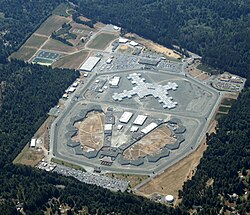Pelican Bay State Prison
 
|
|
| Location | Crescent City, Del Norte County, California |
|---|---|
| Coordinates | 41°51′18″N 124°09′00″W / 41.855°N 124.15°WCoordinates: 41°51′18″N 124°09′00″W / 41.855°N 124.15°W |
| Status | Operational |
| Security class | Supermax |
| Capacity | 3,319 |
| Population | 2,239 (as of March 2016) |
| Opened | 1989 |
| Managed by | California Department of Corrections and Rehabilitation |
| Warden | Clark E. Ducart |
Pelican Bay State Prison (PBSP) is the only supermax state prison in California. The 275 acre prison is located in Del Norte County, California. The prison takes its name from a shallow bay on the Pacific coast, about 2 miles (3 km) to the west. The prison lies in a detached section of Crescent City, several miles north of the main urban area and just south of the Oregon border. PBSP was designed to keep California's known "worst of the worst" prisoners in long-term confinement in a Security Housing Unit (SHU).
Pelican Bay opened in 1989. Pelican Bay's grounds and operations are physically divided. Half of the prison holds Level IV inmates in a General Population (GP) environment with outside exercise courts and yards. The other half of the prison contains the prisons best-known feature: an X-shaped cluster of white buildings and barren ground known as the Security Housing Unit, or SHU. An electric fence surrounds the entire perimeter.
The 8-by-10-foot (2.4 m × 3.0 m) cells of the SHU are made of smooth, poured concrete with perforated cell fronts and doors. There are no windows located within the cells. Instead, there are fluorescent lights, which the inmates can control. SHU inmates are confined to their assigned cell for up to twenty-two hours a day, looking out through a perforated steel door at a solid concrete wall. Food is delivered by correctional officers twice a day (breakfast, sack lunch, and dinner), through a slot in the cell door.
Each of the twenty-two housing units located in the SHU has an armed correctional officer in a Control Booth. Control booths are located in the center of each housing unit. The control officer can view into all six pods in the housing unit, from their central vantage point. The control officer controls the doors throughout the housing unit, which contains six pods. Each pod contains eight cells. The officer can supervise the release of inmates assigned to the housing unit. The control officer can allow one, or two inmates, if they are cell mates (cellies), out of their assigned cell to shower or exercise. Inmates are allowed to exercise for up to ten hours of court-mandated, outdoor exercise per week. Exercise takes place in a concrete yard, which extends the length of three cells, and has a roof partially open to the sky.
Inmates, their lawyers, and prisoner advocate groups have argued that confinement in the SHU is cruel and unusual punishment, due to severe conditions. Contrary to popular belief, the SHU is not composed of solitary confinement cells. Inmates housed in the same pod can talk with each other and even see each other when released from their assigned cells. The SHU consists of twenty-two housing units, with six pods per housing unit and eight cells per pod. Some psychiatrists and psychologists who support inmates housed in the SHU have described a "SHU syndrome", a condition which, they say, affects inmates who spend more than a few months in isolation. The symptoms reportedly resemble those of post-traumatic stress disorder, including hallucinations, depression, anxiety, anger, and suicide. The cause of most of these symptoms is isolation; most SHU inmates experience isolation for 22 hours a day with limited human contact other than receiving meals through a slot in the cell door.
...
Wikipedia
